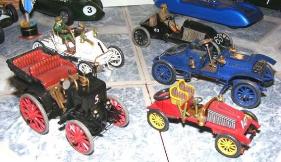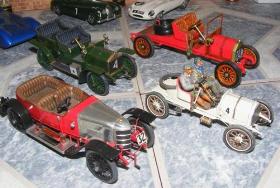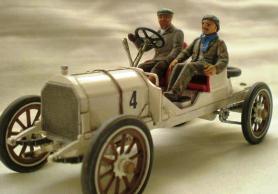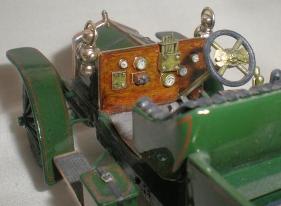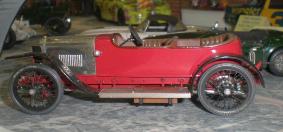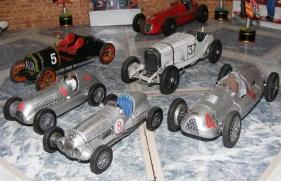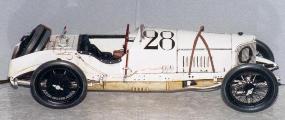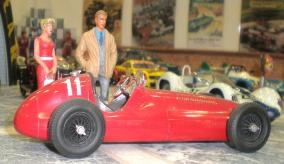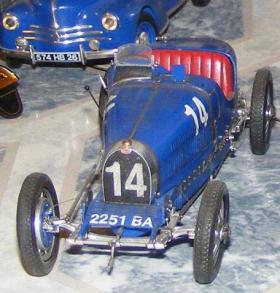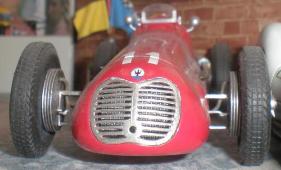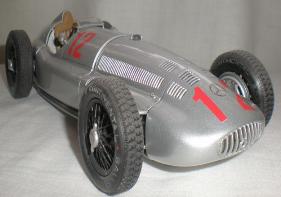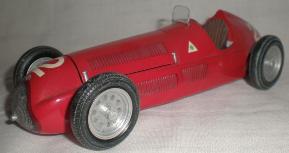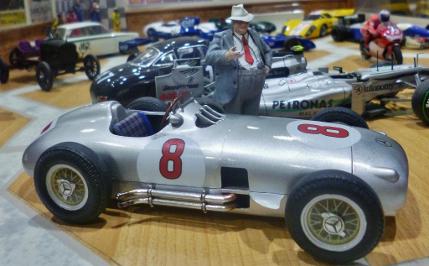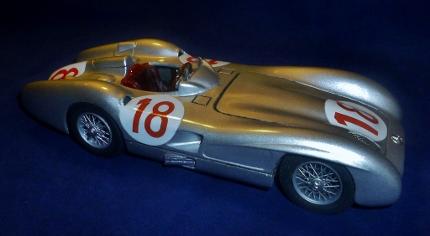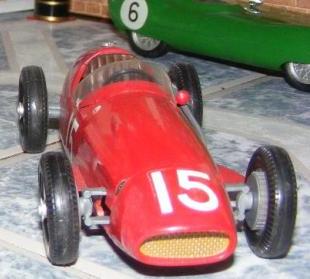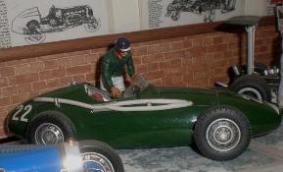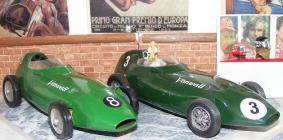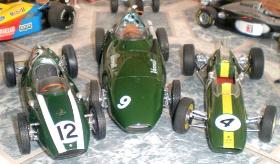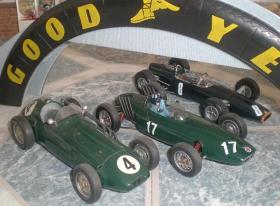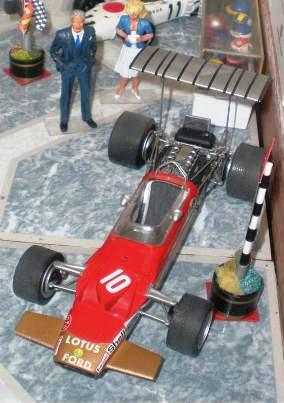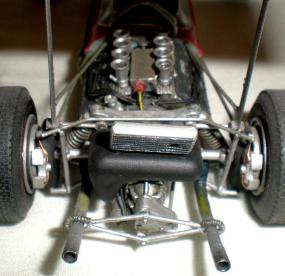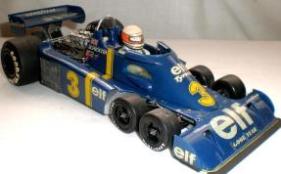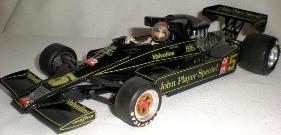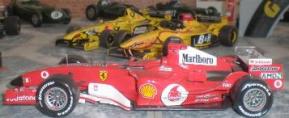Hall Three, the hall of motor sports.
Almost as soon as there were two cars people had to compete against each other. Beyond this normal manifestation of human nature it was necessary to prove the car as a reliable and useful mode of transport, every body knew that a horse could get them where they wanted to go, why bother with cars? On this page we will present some of the historic moments and technological advances that have occurred in over 100 years of motor racing.
The early years.
City to City races. 1895-1903
The early 'races' were really reliability trials and the biggest question wasn't neccasserily who will win but who might make it to the end. Emile Levassor answered the question resoundingly in 1895 but being first home didn't make him the 'winner', proving controversy and contradiction have been a part of motor racing right from the start.
These early events were also hugely important to the areas the races ran through bringing tourism and trade as well as advertising and recognition for the competing companies. Just like today countries and regions vied to atract races and encouragen news papers and advertising, the drivers would become heros and the cars became icons.
These five cars in 1/32nds scale are all examples of the how road cars and race cars looked very similar in the era of city to city racing. But the technologies pioneered in the racing environment were quickly put to work on road cars as sales were key as the fledgeling motor industry started to secure itself a position world of transportation.
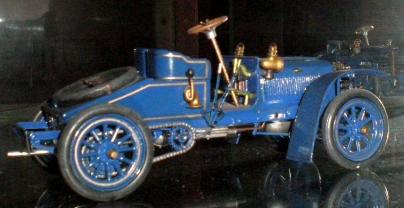
Panhard-Levassor won what is widely believed to be the first motor race in 1895. Car #5 is a conversion of the Europe 1/32nd scale PL kit. It was more of a trial than a race, running from Paris to Bordeaux and back.
Car #1 is PL's 1898 winning car from the Paris-Amsterdam race. Although the rear wheels are still larger than the front other developements are clearly taking shape. The car is lower and has a steering wheel rather than a tiller.
1/32nd scale scratch built model.
The smaller red Renault #147 is a simple kit in 1/43rd scale. It was the winning car in the 1902 Paris-Vienna race.
The Renault bros’ were pioneers of shaft drive to the rear wheels instead of chains. The black Renault (#63 at the back of the group) is a scratch built representation of Marcel Renault’s 1903 lightweight that crashed and killed him during the Paris Madrid race.
The 1903 Paris Madrid race marked the end of an era in motor racing. Eight people died, including Marcel Renault, and many more were injured in a number of incidents leading to the French government stepping in and halting the race at Bordeaux. The great city to city races were over and races would now be run on closed and guarded roads usually over several laps of a circuit.
This de Dietrich, converted from the Airfix kit in 1/32nd scale , also took part in that ill fated race of 1903.
Going in different directions. 1903– 1930
James Gordon Bennett jr', the news paper magnet, sponsored a series of annual races to help promote the motor car. It was run along national lines and is the reason national racing colours were introduced. They were also the first races to have rules specifying sizes of engine and weight. But they were often run concurrent to the great City to City races untill Britain won. Having laws to prevent the closure of public roads, and no actual racing circuits, a compromise had to be found. A closed road circuit in Ireland started Britain on it's road to building specialist racing circuits but for those who enjoyed the 'road racing' it also the established 'TT' races on the Isle of man.
City to City races faded and more and more circuits were built across Europe but the way motor sport seperated meant that races on public roads would go on to create some legendary races. Italy would establish the Mille Miglia and the Targa Florio while in France le Mans would become a Mecca for sports car racing. Trials of motor cars, rather than racing, gave us hill climbs and races across unmade roads and open mountain lands, such as the Prince Hienrich trials and the Alpine Rally, and somewhere in the middle the 'Rally' format was born.
Basically while specialist racing cars for the 'Grand Prix' series moved ever further away from the road vehicles the industry still wanted to establish their marque as the most durable and reliable and the less wealthy folks still wanted an affordable way to race and express themselves.
This group of 1/32nd scale model cars are representative of this variation in racing forms. Touring and sports car racing, hill climbing and open road racing. It also shows how model kits can be converted by the omission of parts and the addition of new scratch built parts.
Having won the 1903 race Britain was obliged to host the 1904 race. By law it was an offence to block the King's Highway so it had to be held in Ireland and was won by the Germans. Camille Jenatzy driving an 60hp Mercedes. The white car no4 is a conversion from the Airfix 1/32nd scale kit.
After the dust had settled from the 1903 Paris Madrid traumas motor races were held over closed roads. In Britain it was illegal to close a public highway so no races could take place on the main land. How ever the Isle of Man had it’s own laws so could hold races.
Rolls Royce are not well known for racing but it was a light 20 of 1906 that won the I.o.M. tourist trophy that year. The 1/32nd scale model is a conversion of the Airfix 1906 RR kit. Note the change to wire spoked wheels.
In Italy there were lots of races often promoted by wealthy aristocrats. In Sicily the Targa Florio was attracting many entrants and gained headline coverage around Europe. Itala featured well in several of these races. The red car at the back of the group is1906 Itala, it’s from a shell Italy promo kit.
The 1913 Vauxhall ‘Prince Henry’ takes it’s name from the cars victory in the Prince Hienrich trials and is modelled in Hill climb trim. Converted from the Airfix kit in 1/32nd scale.
The Grand Prix era begins. 1906-1949
In 1906 the first Grand Prix was held, over two days, near le Mans in France. Won by a Renault it maintained the idea of French automotive superiority but this and the Grand Prix idea were far from secure. Grand Prix races even had a two year hiatus when a sort of 'Formula libre' open event style of racing was held. But the idea of engineering specifications for racing was upheld and little by little the Grand Prix' became the premier national races and the idea of a standard formula took hold. Naturally a European championship developed but niether France of Italy got a good hold on the regulations; it was the Germans that would dominate.
Here we have a group of 1/32nd scale models which demonstrate two things.
1- Racing was still diverging and it was still common for the Grand Prix car to also take part in hill climbs.
2- The German engineering was to outstrip all other nations in the 1930s, in sports cars and grand prix.
The black 1910 Alfa, (pre Romeo), grand prix car took part in hill climbs as well as Grand Prix. Our model is scratch built in 1/32nd scale.
Mercedes silver arrows are well known but they started off being white. The last GP before WWI was the 1914 French GP. It was won, ominously, by the Germans in the shape of a Mercedes driven by Christian Lautenschlager. Car #28 is a serious reworking of the Lindberg 1/16th scale kit.
In the mid 1920s Bugatti dominated motor racing with their type 35 range, not just grand prix but many other events too, from long distance rally style events to hill climbs, a T35 was the car to have.
Monogram give us this fantastic kit in 1/24th scale.
M-B briefly withdrew from racing in the early 1930’s due to the depression and financial issues but Rudi Caracciola drove his private white SSKL, #37, to win the German GP and the Mille Miglia In 1931. In fact the combination won every event they entered that year. This model is converted from the 1/32nd scale Matchbox kit.
Once the Nazi’s state funding began, both M-B and Auto-union began a campaign that resulted in German domination of GP racing pre-war. AutoUnion's intuitive design put the engine in the middle of the car and featured many advanced ideas. Difficult to drive for some they developed into highly potent machines, dominated 1937. The W25 Mercedes no4 is a restored and detailed ‘Dinky’ car while the W125 no8 is from a Newray auto kit. Both are 1/43rd scale. Matchbox produced the 1938 ‘D’ type Auto union driven by Tazio Nuvolari to win the Donington park GP in England. It is 1/32nd scale.
Italy’s main GP contenders were from Maserati and Alfa Romeo. The red #11 Maserati 4CLT modelled here is from the Merit 1/24th scale kit. I cast new wheels and bought new tyres from South Eastern Finecast, to improve the look of the car.
Alfa Romeo’s158 car was making a name for itself in the voiturette class races unknowingly preparing for the post war F1.
In the 1930s Britain's GP record was woeful and that did not sit well Ramond Mays. He had had some 'local' success with Riley 'Specials' and when he was able to bring Reid Railton in on his plans the pair decided it wasn't worth trying to compete in the GP races which were dominated by Italian and German cars. Instead they decided to build a 'voiturette', the F2 racing of the day, which supported the GP meetings.
English Racing Automobiles was born and had a lot of success in British racing, and on the continent.
One of the most famous E.R.A.'s was R2b, known as 'Romulus'. Prince Chula of Siam ran 'the white mouse stable' for which his cousin Prince Bira drove. In the end they ran 3 E.R.A.s for British and European races with a considerable amount of success.
Their legacy would be B.R.M. GP, and Bristol le Mans, success.
South Eastern Finecast produce this 1/24th scale white metal kit.
By 1935 Germany had a strangle hold on GP racing and AutoUnion and Mercedes-Benz took it in turns to win the European championship. The brilliance of Tazio Nuvolari brought some rare wins for Alfa Romeo and even when the Italians tried to turn things in their favour by changing the rules for the 1939 Tripoli GP Mercedes could build a smaller engined version of the RW163 with which Hermann Lang won the race.
Revivals 1/20th scale kit of the 1939 Mercedes, silver #12, is our representation of the car with which Herman Lang won the shortened European drivers championship.
The new Formula. 1950-
Motor racing took up again after WWII but cars were often pre-war models and Europe was not in a position to spend huge amounts of money on motor racing.
To try to provide an equal opportunity that participants could afford Formula one was instigated in 1950. The best prepared nation were the Italians. Alfa Romeo, Maserati and Ferrari could all field cars in racing events.
It was Alfa Romeo who triumphed in both 1950 and ‘51. Here are two of Merit’s 1/24th scale kits, Farina’s 1950 158 Silverstone car and below is Fangio’s 1951 159 Silverstone car on the right. The 159 has conversions and super detailing. Alfa Romeo were losing their dominance to Ferrari in 1951 and in their efforts to stay ahead also created the 159M, a widened body to hold adition fuel as the engine was moving into the realms of gallons per mile rather than the the usual MPG!
France’s hopes were with Talbot Lago and Simca-Gordini. Here are Merit kts from the 1960s. Basically two men who were draging old fashioned companies into a new era, Antony lago doing so off the track too.
It was never going to be easy for the little French concerns to compete without the backing of their motor industry and Gordini imparticularly worked engineering wonders to squeeze performance out of his cars. Despite the best efforts of dazzling young drivers and pre-war stalwarts, like Jean-Pierre Wimille, Gordinis rarely got the better of the Italian competition, and worse would come in 1954 when the Germans returned.
For Talbot-Lago pre-war legend, Louis Chiron, Louis Rosier, would win Grand Priw and even le Mans using the T26 series cars. They could almost compete against the Italian machines due to their fuel economy, there by doing less stops for fuel. Even more astounding is that most of the parts for these cars were shared with the pre-war and road ranges.
Our blue Talbot-Lagos are in 1/24th scale from the Merit range; the light blue car being a period build from the 1950s while the darker blue car is a 1990s build. This allows us to compare the model making accessories and techniques from the two eras.
The yellow Talbot T26 is modelled as Jonny Cleas car from 1950 Monaco GP, from the Heller kit, all are 1/24th scale.
Mercedes only competed for two season in the ‘50’s, 1954 and 1955, but they were all conquering. The great Juan Manuel Fangio took successive drivers championships in '54 and '55. Fangio and Stirling Moss were closely matched and Moss followed Fangio so closely the pair became christened "the train". Mercedes stars drove stream lined cars for the high speed Monza race of 1955, the number 18 car being that of Fangio.
The Mercedes W196 debut at Riems in 1954 was a streamlined car and it was some how fitting that the last race for the car was also a victory for the stream lined version.
1/24th scale CustomFX kit.
The Brit's are coming. 1955 to 1969
While the Europeans were winning all the races the British were planning a take over. Easier said than done and B.R.M. spent years, and a lot of money, trying to compete. What they did achieve was bringing like minded people together so that out of B.R.M.’s trials Vanwall could be born.
But before all the ‘big names’ got going it was the small team of Connaught that won the first post war international GP for a British car. At Syracuse in 1955. On display in the museum is a model of that car made from resin castings off of a 1/24th Merit kit. The model has many scratch built parts detailing it.
Vanwall’s challenge resulted in winning the inaugural F1 constructors championship in 1958. They missed the drivers championship when Mike Hawthorne (Ferrari) beat Stirling Moss by a single point.
Here we have two Merit Vanwalls in 1/24th scale. #8 is Rod’s original model straight out the box, while #3 is Ian’s car made in the 1990’s. It is upgraded with wheels and tyres from South Eastern Finecast.
As the 1950’s turned into the 1960’s the British makes not only established themselves but turned the F1 world on it’s head. Cooper Led the rear engine revolution and Lotus brought in monocoque chassis as everyone else struggled to keep up with the technological pace never mind the cars. Three 1/20th scale models help tell this story. The Cooper is by MRM as is the Vanwall. The Lotus is from Tamiya’s kit.
B.R.M. came good in the 1960’s winning the drivers championship with Graham Hill in 1962.
Here are three of their cars, all in 1/24th scale. The P57 series, #4 would give the marque their fist win in 1959 driven by Jo Bonnier.
When Graham Hill joined B.R.M. in 1960 he joined a team in conflict and worked with Tony Rudd side to create a new simpler style of car which followed the Cooper lead and in 1962 earned Graham Hill his first world championship.
Lotus raised the bar again in 1967 with Lotus 49 using the engine as a fully stressed member. Equally important in the history of F1, though not known at the time, was that the engine was the Cosworth DFV.
The 49b won the world championship with Graham Hill in 1968. the Cosworth engine went on to win many races and championships wth a variety of teams.
Marking these historical points for the museum is this 1/24th scale kit from Heller. Super detailed of course.
Continuing development. 1970-
To the casual observer the most notable change as racing entered the 1970s was the death of national colours. Advertising transformed the way cars looked but this was only skin deep. Behind the scenes teams became ever more secretive and extreme in their efforts to get ahead of the competition.
Safety at race tracks was starting to become a much more serious matter. The reigning world champion Jackie Stewart led the drivers side and Brabham owner Bernie Ecclestone started to bring the teams together to not only focus on safety but on their own rewards from Television revenue, gate reciepts and a say in how the F1 rules might be changed; something that ultimately led to strikes, half grids and the infamous FISA/FOCA war.
Byt the end of the 1970s tyres were totally treadless and increasingly huge at the rear. Cooling radiators were slidding down the sides of the cars to the rear and aerodynamics became the centre of a controvasy that had the Television companies airing documentaries with titles like "Gentleman, raise your skirts"!
Great British world championship winning team,Tyrrell, were running in French blue! Displaying the colours of their French sponsors.
This Tyrrell 003 is from the 1/25th scale Doyusha kit.
Tyrrell had set a precedent when they built the 001 in near total secrecy and followed this with another 'top secret' project; Project 34. In an effort to aid handling and reduce drag from wind resistance Tyrrell opted for four small wheels at the front. The look was astounding and as devisive then as it still is now, but technical progress was marching on.
Tamiya produced this lovely kit in 1/20th scale which would still be selling 35 years later!
The search for performance was exemplified by Lotus who ushered in 'the ground effects' era with the Lotus 78. It took a while for other designers to catch on to Colin Chapmans idea and while they were busy copying the outward apperance they were not fully aware of the wing cars underside aerodynamics.
Another of Tamiya's great kits from the 1970s is the 1/20th scale Lotus 78 of Mario Andretti.
Ferrari stayed faithful to their excellent flat 12 engine but were hampered by the fact that it stopped them getting the best out of ground effects. This was best achieved by, hitherto alsorans, Williams, who beat Lotus at their own game with the outstanding FW07 series that ran for three seasons.
All are Tamiya's 1/20th scale kit, or conversions of the same FW07 kit.
Turbo power and the 1980s
1980 Osella FA1 "MS Denim"
Designed by Giorgio Stirano, the monocoque chassis was made from Aluminium honeycomb as was the standard of the time. It was a wing car using air flow under the car to suck it down onto the track.
Unfortunately the car was around 100kg over weight, which created a real handicap at the start of the season. This preponderance was reduced to 45kg in the FA1b but it wasn't enough to make a difference. Eddie Cheever tried to qualify the car all season but in a disappointing year failed to reach the grid 4 times and never saw the chequered flag at all.
Hi-Fi Automodelli kit in 1/43rd scale
In the 1970s, Renault had opened a loop hole in the rules when they took up the turbo challenge, basically arguing that 'turbo' charging was the modern equivalent of superchargers. Of course they work in different ways, but both are to do with forced induction so the Renault were allowed to compete; especially as they weren't terrible good or reliable so no one really bothered about them.
Ground effect had made cars fast around the corners and Turbo's would make them rockets down the straights. But not straight away, it was going to take a lot more expensive research to iron out all the kinks and make them reliable.
On the Safety front Profesor Sid Watkins was starting to get his way and all sorts of innovations of the 'Profs' would save the lives of F1 drivers, even if some of the drivers weren't so sure they wanted too be safer! Circuits came under more rigorous scrutiny too and by the end of the decade the pendulum of power in the sport seemed to have swung away from the rule makers leading one Jean Marie Balestre to make some breath-taking decisions that ultimately saw him ousted from his position as president of the FIA
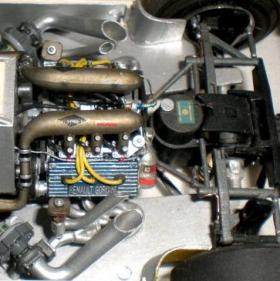
Tamiya produced the 1/20th scale Re30b, below, the Renault turbo engine is to the left.
While we took time to note that Tyrrell had paid respects to its French sponsors by wearing a French blue livery that is a bit of a read herring. Elf corporate colours were blue white and read anyway. So it is not really a surprise to see Elf sponsorship giving way to the Renault colours of Yellow White and Black. Not even a whiff of French Blue anywhere; except for the Gordini covers perhaps.
Ferrari eventually gave up on the flat twelve and moved onto the turbo. It would take them a while to get on top of this technology too but they certainly benefited in the ground effect area by running a V6 turbo.
Protar’s 1/24th scale Ferrari 126C2 of 1982 is shown above, and Ferrari's 1985 F1-85 turbo engine is shown on the left.
The age of 'driver aids', or computer technology to be more precise; the 1990s
Turbo power was so great that it was banned for F1 in 1989, and a new generation of technical guru's would come into their own in the 1990s. Computors had revolutionised the world in our homes and at work, they were getting smaller and more powerful, so much so that they could be carried on board the ultra light racing cars of the F1 circus. Soon engine adjustments were made with a key board not a spanner, and a new set of gadgets and controversies would revolve around the sport.
These computor based driver aids were much harder to police than ball bearings in a water cooling system for brakes. Rumours of cheating became accusations, which became legal battles, which turned F1 into a soap opera rather than a sport.
F1’s designers looked for new ways to claw back performance. Aerodynamic advances saw Tyrrell start the move to high noses on the Tyrrell 020.
Tamiya’s1/20th kit allowing us to show the anhedral design.
The Williams Fw14b of 1992 had Adrian Newey working on it’s aerodynamics but the team had also perfected computer controlled active ride. All of a sudden a man with a lap top was as important as the blokes with the spanners.
Hasegawa’s 1/24th scale kit has had more than a little extra detailing.
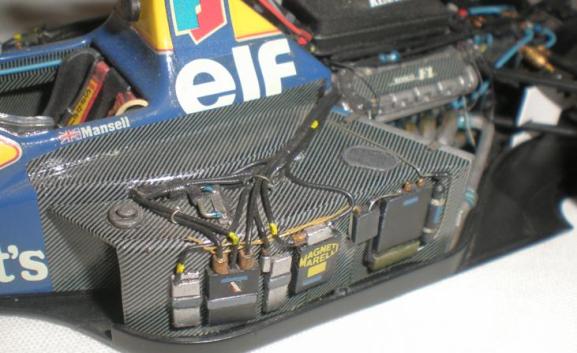
A new revolution, the 2000s
The aero devices and ‘flip ups’ on this 2005 Ferrari, in 1/24th by Revell, bear witness.
Ever since then the quality of the racing has declined as aero dependence interferes with close racing, and the endless scramble to harness areodynamic effects to garner hundredths of a second in time per lap has left us with some of the ugliest cars we've ever seen.
By 2010 the rules were against so many of the turning vanes, splitters winglets and fins that they disappeared but were replaced by a more ingenious aerodynamic aid; drag reduction by stalling the airflow over the rear wing.
Mercedes also made a return to F1 as a manufacturer team buying up the 2009 World champions Brawn GP. However, any thoughts of a dominant German 'Silver Arrows' team like the those of the 1930s and 1950s didn't materialise.
Revell provided us with the Mercedes W01 model kit in 1/24th scale.
"We're going through changes", the 'Teens.
A decade of sweeping changes saw aerodynamics and safety at the centre of wholesale changes. The look of the cars changed dramatically with smaller wing front and rear and new nose shapes to reduce the risks of side impact penetration into the cars cockpits. If the cars had been ugly with all the winglets, fins and splitters they were absolutely hideous with the raised noses and 'bumpers' that arrived in 2014.
Saving money remained a central theme as did 'going green' so KERS and other energy recovery systems coming into the sport. Turbos came back too, V6 style, but with all the electronics and electrical energy boost systems they sounded like large motorcycle engines rather than highly stressed racing engines.......
Fans had a lot to say about all the issues!
